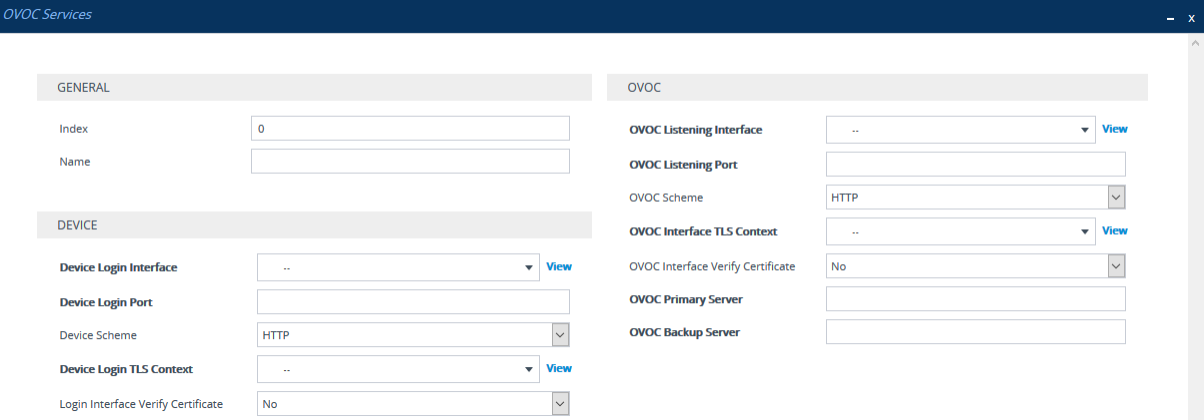Configuring an HTTP-based OVOC Service
The OVOC Services table lets you configure a single HTTP-based
A summary of the steps required to configure an HTTP Proxy for this OVOC service is listed below:
| 1. | Enable the HTTP Proxy application (see Enabling the HTTP Proxy Application). |
| 2. | Configure two local, listening IP network interfaces - one for OVOC and one for the IP Phones (see Configuring IP Network Interfaces). |
| 3. | Configure the OVOC service in the OVOC Services table (described below). This entails specifying the IP network interfaces as well as the port number within each interface to which the HTTP Proxy must listen to. |
| 4. | Configure the device's firewall (Firewall table) to allow incoming traffic from OVOC. For more information, see Configuring Firewall Rules to Allow Incoming OVOC Traffic. |
| ● | It is recommended not to use port 80 as this is the default port used by IP Phones for their Web-based management interface. |
| ● | No special configuration is required on the managed equipment. |
The following procedure describes how to configure an OVOC service through the Web interface. You can also configure it through ini file [OVOCService] or CLI (configure network > http-proxy > ovoc-serv).
| ➢ | To configure an OVOC Service: |
| 1. | Enable the HTTP Proxy application, as described in Enabling the HTTP Proxy Application. |
| 2. | Open the OVOC Services table (Setup menu > IP Network tab > HTTP Proxy folder > OVOC Services). |
| 3. | Click New; the following dialog box appears: |

| 4. | Configure an OVOC Service according to the parameters described in the table below. |
| 5. | Click Apply, and then save your settings to flash memory. |
OVOC Services Table Parameter Descriptions
|
Parameter |
Description |
||||||||||||
|---|---|---|---|---|---|---|---|---|---|---|---|---|---|
|
General |
|||||||||||||
|
'Index' [Index] |
Defines an index number for the new table row. Note:
|
||||||||||||
|
'Name' service-name [ServiceName] |
Defines a descriptive name, which is used when associating the row in other tables. The valid value is a string of up to 40 characters. By default, no value is defined. Note:
|
||||||||||||
|
Device |
|||||||||||||
|
'Device Login Interface' device-login-interface [DeviceLoginInterface] |
Assigns an IP network interface (local, listening HTTP interface:port) for communication with the client. To configure IP Interfaces, see Configuring IP Network Interfaces. By default, no value is defined. Note:
|
||||||||||||
|
'Device Login Port' device-login-port [DeviceLoginPort] |
Defines the login port of the requesting client. Note: The NGINX directive for this parameter is "proxy_bind". |
||||||||||||
|
'Device Scheme' device-scheme [DeviceScheme] |
Defines the protocol for communication with the requesting client.
Note: If configured to HTTPS, you must assign a TLS Context (see the 'Device Login TLS Context' parameter, below). |
||||||||||||
|
'Device Login TLS Context' device-login-tls-context [LoginInterfaceTLSContext] |
Assigns a TLS Context (TLS configuration) for the interface with the requesting client. This is required if you have configured the 'Device Scheme' parameter to HTTPS (see above). To configure TLS Contexts, see Configuring TLS Certificate Contexts. Note: The NGINX directive for this parameter is "proxy_ssl_certificate", "proxy_ssl_certificate_key", "proxy_ssl_ciphers", and "proxy_ssl_protocols". |
||||||||||||
|
'Device Login Interface Verify Certificate' device-interface-verify-cert [LoginInterfaceVerifyCert] |
Enables the verification of the TLS certificate that is used in the incoming client connection request.
Note: The NGINX directive for this parameter is "proxy_ssl_verify". |
||||||||||||
|
OVOC |
|||||||||||||
|
'OVOC Listening Interface' ovoc-interface [OVOCListeningInterface] |
Assigns an IP network interface (local, listening HTTP interface:port) for communication with OVOC. To configure IP Interfaces, see Configuring IP Network Interfaces. By default, no value is defined. Note:
|
||||||||||||
|
'OVOC Listening Port' ovoc-port [OVOCListeningPort] |
Defines the listening port for the OVOC interface. Note: The NGINX directive for this parameter is "proxy_bind". |
||||||||||||
|
'OVOC Scheme' ovoc-scheme [OVOCScheme] |
Defines the security scheme for the connection with OVOC.
Note:
|
||||||||||||
|
'OVOC Interface TLS Context' ovoc-interface-tls-context [OVOCInterfaceTLSContext] |
Assigns a TLS Context (TLS configuration) for the OVOC listening interface. This is required if you have configured the 'OVOC Scheme' parameter to HTTPS (see above). To configure TLS Contexts, see Configuring TLS Certificate Contexts. Note: The NGINX directive for this parameter is "proxy_ssl_certificate", "proxy_ssl_certificate_key", "proxy_ssl_ciphers", and "proxy_ssl_protocols". |
||||||||||||
|
'OVOC Interface Verify Certificate' ovoc-verify-cer [OVOCInterfaceVerifyCert] |
Enables the verification of the TLS certificate that is used in the incoming connection request from OVOC.
Note: The NGINX directive for this parameter is "proxy_ssl_verify". |
||||||||||||
|
'OVOC Primary Server' primary-server [PrimaryServer] |
Defines the address (IPv4 or IPv6) of the primary OVOC server. Note:
|
||||||||||||
|
'OVOC Backup Server' backup-server [BackupServer] |
Defines the address (IPv4 or IPv6) of the secondary OVOC server. Note:
|
||||||||||||